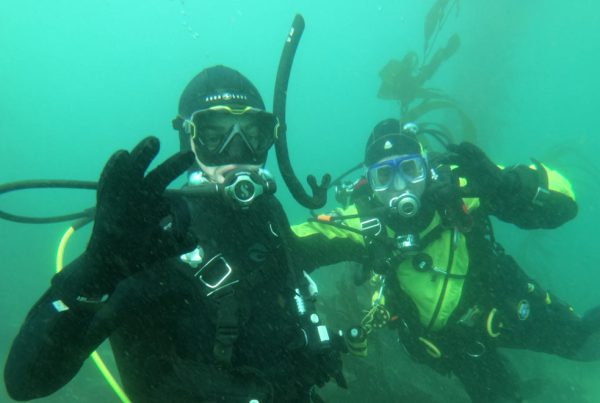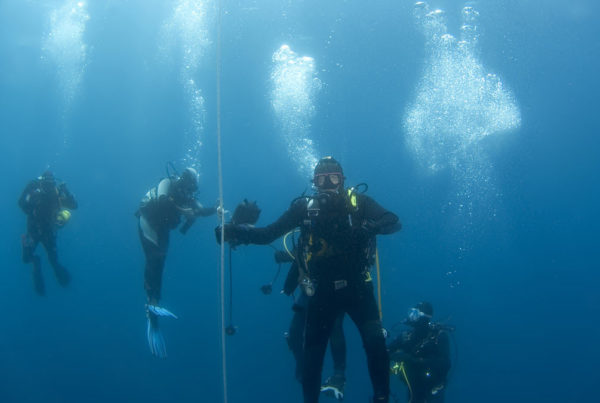MORE THAN THE USUAL REASONS FOR THE BUDDY SYSTEM
While solo diving is okay in very specific, shallow, and easy situations by highly experienced and trained divers using specific equipment, diving with a good buddy is always the preferred way to dive. But not just for safety.
You will almost assuredly get more enjoyment out of a dive with a buddy simply because you will have somebody with which to share the adventure. Some of the best friendships I’ve made through my lifetime were largely centered around shared underwater experiences. Diving can be very life enriching. Why not share such adventures with another?
Also, you will see more. We divers tend to be tunnel-visioned underwater, only seeing a small section of the underwater panorama at any given time. With a second set of eyes, you’ll nearly double the chance of spotting that special nudibranch or passing fish. Or perhaps your buddy will spot a camera angle or lobster that you missed.
Speaking of camera angles, a buddy can be an important contributor to the efforts of an underwater photographer or videographer. Underwater images with diver involvement are quite effective in telling a story. Have your buddy become a model. A good buddy for a photographer/videographer can also help spot new subjects while the camera operator shoots away.
And finally, a buddy can make those little nuisances of diving much easier. Can’t reach that strap? Need help putting on a heavy tank? A good buddy will be there to help.
SAFETY: THE MOST IMPORTANT (BUT OVERRATED) REASON FOR A BUDDY
Dependance on a buddy to rescue you is a serious error. You cannot be a sloppy diver and expect your buddy to pick up the pieces. You need to be a self-reliant diver, even if you never dive solo. A buddy is, and should only be your final safety net—a safety net that you need none the less. As divers we should have safety backups in layers. Those layers take the form of quick releases, dive knife, safe-second regulators, pony-bottles, supervising divemasters, the surface and, finally, your buddy. Each safety layer is important, some more than others. Some you dare not remove, others would compromise your safety, but not completely eliminate it. But why eliminate any layers? So hang on to your buddy.
BUDDY SYSTEM IS ONLY AS GOOD AS YOU MAKE IT
Any buddy system for safety, however, is only as good as it is set up and maintained, much as with any piece of dive gear. There is no denying it, there are bad dive buddies. But most poor buddy situations arise from a lack of pre-dive communication and prep. Do you have common goals on the dive? Hunters and photographers, for example, make poor dive buddies. Do you agree to go the same direction, stay at about the same depth, etc.?
After agreeing on these points, come to an understanding on basic dive procedures: who will lead and who will follow (not always necessary but it is surprising how often this lack of communication leads to problems); procedures in the event of separation; maximum depth;
planned turn-around point to start heading back to shore or the boat (i.e., a specific landmark, 1500 psi); when to ascend (i.e., 700 psi); safety stop plan; concerns about the dive (i.e., potential ear problems, fears, unfamiliar equipment, etc.). Review hand signals. Don’t just assume that your buddy’s will be the same as yours.
Help each other dress in, not just because it makes the dive more enjoyable but also because it will help familiarize yourself with your buddy’s gear. In addition to going through your own pre-dive check on yourself, check over your buddy’s gear once they are dressed in and have them do the same to you. Is the air on? Where are the weight releases? Where is their safe-second regulator? Where is the BC air dump and inflator? Are they carrying any other safety equipment of which you need to be aware, such as air horns, safety sausages, pony bottles, etc.? How do these devices work? Make sure your buddy knows all about your gear. Even simple things make a buddy team work better such as awareness on how your buddy’s tank strap works, fin straps, and BC adjustments. A three-minute check and familiarization before entering the water will save much more time and headaches (or worse) underwater.
CULTIVATING A PERMANENT BUDDY
If you’re hooking up with a buddy that you’ll be diving with often, there are additional actions to put into motion to make your diving more enjoyable and safe. Don’t just talk about emergency procedures but actually practice them. Practice out-of-air emergencies, using safe-second regulators and pony bottles (if you use them). Take a Rescue Diver class together.
For more enjoyment and ease, coordinate the logistics of your diving. Carpool to the boat or beach. Carry just one spare parts kit instead of two (making sure you have the right parts for each diver’s needs).
Although safety is an important reason for having a buddy, it is not the only reason. And the safety aspect of a dive buddy has to approached properly— not as the ultimate safety net, but as just another layer of safety features that include good training, well maintained dive gear, and back-ups.









